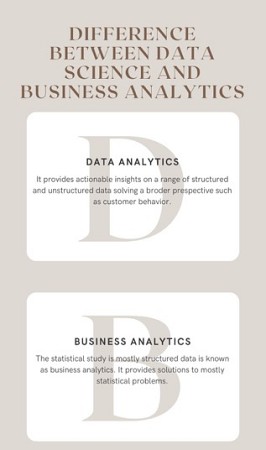Business analytics focuses on determining business plans and executing functional improvements within an enterprise using big data techniques as data processing. Business analytics is used to find gaps in current processes and discover data that can be used to move a business ahead in productivity and other growth metrics.
Data science is a domain that identifies critical business issues such as trends and correlations using technology, mathematical methods, and big data. Data science may help an enterprise become more efficient in collecting knowledge and developing actionable strategies for current or new prospects.
Is data science business analytics?
There are key differences between data science and business analytics. Business analytics is the study of statistics of data to make better business decisions. On the other hand, data science covers all the aspects of statistics, algorithms, and technologies.
Check out our comprehensive table at the end of the article for more about the differences between business analytics and data science.
Bill gates has quoted it very well,
“Information technology and business are becoming inextricably interwoven. I don’t think anybody can talk meaningfully about one without talking about the other.”
What is business analytics?
The process of collecting, sorting, analyzing, and researching business data and using mathematical models and algorithmic methodologies to turn data into business insights is known as business analytics. It tries to find out which databases are valuable and how to use them to solve challenges and improve performance, competitiveness, and sales.
What are the main components of business analytics?
- Data aggregation
- Data mining
- Text mining
- Association and sequence identification
- Forecasting
- Predictive analysis
- Optimization
- Data visualization
Data aggregation:
Data must first be compiled, centralized, and cleaned to prevent repetition, as well as filtered to delete outdated, missing, and unusable information. Data can be obtained from several sources, including:
- Documents that are part of a vast dataset shared by an entity or an accredited foreign entity. They are known as transactional records (banking records, sales records, and shipping records).
- Data provided by the customer in a paper or digital medium and transmitted by the consumer or an approved third party.
Data mining:
Models may be generated by mining large volumes of data to discover and recognize previously undiscovered trends and patterns. To gain clarity, data mining utilizes a variety of analytical modeling, including:
- Classification: Where demographic variables are defined and can be used to sort and group.
- Regression: A mathematical function that is used to forecast constant numeric values by generalizing past trends.
- Clustering: Used to define correlations to decide what variables are present.
Text mining:
Companies can obtain useful relationship measures from social media pages, blog posts, and call center scripts from other sources. This knowledge can be used for several reasons, including:
- Create new services that are in high demand.
- Enhance customer support and satisfaction.
- Examine the success of the competitors.
Association and sequence identification
Consumers sometimes execute identical acts at the same time or follow a repetitive pattern. Patterns can be discovered using this data, such as:
- For example, several books in a series or a toothbrush and toothpaste are often bought in the same transaction as an association.
- Sequencing is the process of putting things in order. For instance, a customer could request a credit report first, then apply for a loan, book an airline ticket, book a hotel room, or reserve a vehicle.
Forecasting:
Analyzing processes that happen over a given time or season may be used to create a forecast of possible events or activities based on prior evidence. Consider the following scenario:
- In any given month or quarter, the energy demands for a city with a fixed population are determined.
- Holiday product shop sales, with the best days for both physical and internet retailers
- Increases in the internet searching for a recurring incident, such as the Football or the Olympics.
Predictive analysis:
Companies should develop, deploy, and manage predictive scoring models to respond to events like:
- Customer turnover with precision narrowed to customer age bracket, income status, account lifespan, and promotion availability.
- Failure of equipment, particularly during anticipated periods of high use or when subjected to extreme temperature/humidity stressors.
- Market dynamics include those that occur exclusively electronically, as well as seasonal or event-related ones.
Optimization:
By designing and applying modeling methods, businesses will recognize the best possible outcomes and following best measures, such as:
- Peak sales pricing and using demand surges for scale production to ensure a stable revenue stream.
- Options for inventory stocking and shipment improve delivery times and customer loyalty without taking up valuable warehouse space.
- To boost profitability and clear the way for growth prospects, choose the best times for purchases, discounts, new technologies, and spin-offs.
Data visualization:
Data-driven information and perspectives can be shown using incredibly immersive graphics to demonstrate:
- Analyzing exploratory results
- Outputs from simulation
- Statistical forecasts
These data visualization elements empower companies to use their data to educate and drive new business strategies, raise sales, and enhance customer relations.
Essential skills needed for business analytics
Following are the key skills that are needed for business analytics:
- Critical thinking: Understanding which data can be valuable in making decisions and thinking objectively about the consequences of the data gathered is an important aspect of dealing with business analytics.
- Curiosity: Working in market analytics necessarily involves an interest in how things function, how they fit together, and how they evolve.
- Problem-solving: Since the ultimate aim of data collection is always to overcome a certain pain point within the enterprise, obtaining this ability makes it easy to link the dots and reach conclusions.
- Detail-oriented: Since those in this area deal with such detailed data, it’s necessary to pay a lot of attention to the many aspects of that data, as well as the suggestions it can present.
- Communication: Acting with those on the staff or sharing conclusions to upper management, being a good communicator by writing and presentation is important.
Benefits of Business Analytics
Business analytics has many advantages, regardless of its scale or the sector in which it works.
One of the most important advantages is that it helps the company to prepare for the future. Business analytics can forecast future developments in an organization’s revenue, earnings, and other primary indicators by modeling current trends. Businesses will also see shifts that could come yearly, seasonally, or on some scale, allowing them to schedule and plan accordingly.
To plan for a poor season, you can need to reduce expenses or invest in new marketing strategies. Larger businesses will benefit from business analytics’ ability to forecast order volume and waste.
Your company can use business analytics to assess new marketing strategies as well. You can study the impact of your advertising campaigns on various markets and demographics because business analytics provides you with data about consumer behavior. You may also consider providing tailored discounts to reclaim the customer’s business if you can determine that they are less likely to return.
You’ll get a strategic edge over the market when you use business analytics to your advantage, regardless of the industry.
Careers in Business Analytics
For those who love dealing with statistics, a career in business analytics is a reliable approach. A bachelor’s degree in business analytics, computer analysis, information processing, business intelligence, marketing, statistics, or a similar area is needed to begin working on a career in business analytics.
What are the current trends for these BA professionals?
As a data analyst or data scientist, you can capture, interpret, and arrange data in such a manner that the enterprise gathers valuable information and can be accessed by all divisions. A data analyst uses tables, maps, and other forms of documentation to present this detail to top management.
A business intelligence analyst is unique in collecting and analyzing data to achieve a competitive edge over their competitors. They’ll show upper management where their company is, its strengths and disadvantages, and how they will increase profits.
Big data analytics experts use the most recent advances in technology and data science to address problems that occur while operating in the digital field. They will often be asked to weigh in on different decisions based on data observations, and they must be able to back up their findings with facts.
Many who seek a career as a marketing manager would be responsible for designing the company’s marketing strategy. Whether you’re in charge of marketing promotions, dealing closely with sales and marketing departments, or accountable to upper management, it all depends on the kind of company and business you work in.
Those who choose a career as a market research analyst can deal with marketing data daily. This type of data would assist in identifying prospective buyers, evaluating the product’s acceptability, and creating unique pricing points to maximize sales over time.
A managing analyst’s position includes helping in company processes and ensuring that they operate effectively and efficiently. You’ll partner with many other divisions to decide which business procedures need to be changed and how to maximize performance.
How much money can you make as a business analyst
| Position | Salary |
| Senior Business Systems Analyst | $86,635 |
| Business Systems Analyst- Consultant | $113,202 |
| Business Process Consultant | $106,234 |
| Business Development Director | $170,307 |
| Entry Level Business Systems Analyst | $56,043 |
| Intermediate Level Business Systems Analyst | $71,865 |
Before we go into Data Science, its career prospects, and also compare Business Analysts and Data Scientists fields and career attractiveness, I’d like to recommend some interesting articles for you to open in a new tab and read next.
-
Can Data Analysis Be Automated? (We Find Out)

Not so long ago, people were used to doing simple repetitive tasks such as performing a simple linear regression by hand, which is quite a tedious task even with the
-
This is Why Business Analytics is Vital to Every Business

In today’s business-centric world, every company in the run wants to have their decision-making systematic and efficient. It is where business analytics proves beneficial to businesses. The question remains, why
-
5 Reasons Why Data Analytics is Important in Problem Solving

Data analytics is important in problem solving and it is a key sub-branch of data science. Even though there are endless data analytics applications in a business, one of the most
What is data science?
With the vast volumes of data generated today, data science is an important part of every industry. Data science is now one of the most widely discussed subjects in the industry. Its popularity has increased over time, and businesses have begun to use data science tools to expand their operations and improve customer loyalty.
Why is data science needed?
Better decision-making, statistical learning, and pattern detection are all driven by data science or information analysis. It allows you to:
- Answer the appropriate questions to find the root cause of an issue.
- Perform an explorative analysis of the data and model it using a variety of techniques
- Graphs, dashboards, and other visual aids may be used to communicate and analyze the performance.
In reality, data science is now assisting the aviation industry in forecasting flight delays to help both airlines and travelers escape discomfort. Airlines can improve their operations in a variety of ways with the aid of data science, including:
- Predict flight delays, build predictive analytics models.
- Provide travelers with customized discount packages based on their booking habits.
- Choose which plane class to buy for improved overall results.
Must-know algorithms for data science:
A data scientist’s most simple and important algorithms to learn are:
Regression:
Regression is a machine learning algorithm that utilizes deep learning techniques. An actual or constant value is the product of regression. For instance, predicting a room’s temperature.
Arranging
Grouping is an unsupervised machine learning technique. It takes a series of unidentifiable data points and organizes them into clusters.
Decision tree
A decision chain is a controlled learning system that is most often used for identification. The algorithm categorizes the different inputs based on a single parameter. The most important advantage of a decision tree is that it is simple to comprehend and that the explanation for its grouping is clearly shown.
Tools used as data science skills:
| Field | Tools |
| Data Warehousing | Informatica/ Talend, AWS Redshift |
| Data Analysis | SAS, Jupyter, R Studio, MATLAB, Excel, RapidMiner |
| Machine Learning | Spark MLib, Mahout, Azure ML studio |
| Data Visualization | Jupyter, Tableau, Cognos, RAW |
Benefits of data science:
The field of data science is in high demand. Work hunters have a plethora of options available to them. It is the fastest rising work on Linkedin, with 11.5 million jobs expected to be created by 2026.
Only a few people possess all of the necessary skills to become a full-fledged Data Scientist. As a result, Data Science is less saturated than other IT markets. As a result, Data Science is a vastly diverse area with many resources. The area of data science is in high demand, but there are few Data Scientists available.
One of the highest-paying occupations in data science. Data Scientists receive an average of $118,100 a year. As a result, Data Science is a very lucrative career choice.
Data Science has a wide range of uses. In the health-care, finance, consulting, and e-commerce sectors, it is commonly used. Data science is a discipline with a wide range of applications. As a consequence, you will be able to function in many areas.
Data scientists are required by companies to process and interpret their data. They not only evaluate but also increase the accuracy of the results. As a result, Data Science is concerned with enriching data and making it more beneficial to their company.
Machine Learning has allowed businesses to develop better solutions designed specifically for consumer needs thanks to Data Science. E-commerce portals, for example, employ Recommendation Systems to provide consumers with customized recommendations based on their previous orders. As a result, machines are now capable of comprehending human actions and making data-driven decisions.
Data science will assist you in answering questions such as:
- What are the demographics of the average ice cream consumer?
- Would my customers tip more if I play top 40 songs on the radio?
- What is the right regional area for a new ice cream shop to open?
- What month do I sell the most ice cream throughout the year?
A company’s ability to implement the best market analytics approach cannot be accomplished immediately. However, when concrete best practices are implemented, you can be assured that the insights you obtain can help the company achieve maximum success. The below are some of the best practices:
- Before using market analytics, you can define your business use case and target.
- Choosing precise performance and loss parameters.
- Validating templates based on the performance and loss criterion.
- Making an accurate forecast requires developing a technique, narrowing down the numbers, and assessing the internal and external variables that go into it.
When you put in the work to implement these four moves, you can be assured that data-driven decision-making will help the organization the most.
Business analysts and computer scientists solve a variety of challenges
Understanding the issues or tasks that a market analyst and a data scientist focus on is critical. Let’s look at a fascinating case in point. Assume you are the CEO of a bank and you have decided to execute two major schemes. You have a data scientist and a market analyst on your staff. What method would you use to plan out the project? The following are two statements that pose a problem:
- Build a strategic plan to assess how many workers a bank will need in 2021 to perform XXX business. Create a model to forecast which transactions will be fraudulent.
- Take the time to grasp the issues. Which dilemma, in your opinion, is better suited for which profile?
Take the time to grasp the issues. Which issue, in your opinion, is better suited for which profile?
Having many market decisions and integrating macro improvements into the approach is needed for the first issue statement. This will necessitate additional industry experience and decision-making, which is what a business analyst will be responsible for.
The second issue statement necessitates analyzing large amounts of consumer behavioral data and identifying latent trends. This includes detailed knowledge of problem formulation and algorithms on the part of the practitioner. A data scientist would be the best person to deal with such a particular and challenging situation.
Key differences between Data Science and Business Analytics

It’s not clear how enterprise analytics and data science vary from one another, much as it is with business intelligence. Both include data collection, simulation, and the extraction of different insights.
The distinction between the two derives from business analysts’ emphasis on business-related topics such as expense and benefit and its willingness to foresee what could happen in the future.
The larger or superset of the two is data science, which focuses on answering questions about consumer habits, seasonal influences, and geographic location within the company. To answer these questions, it integrates data with algorithm creation and technology.
In a nutshell, data science is the science of using analytics, algorithms, and technologies to analyze data. The mathematical analysis of market data is known as business analysis.
| Area of Comparison | Data Science | Business Analytics |
Subjects Covered | It is a branch of science that uses analytics, algorithms, and technologies to analyze data. | It includes the statistical study of data for business. |
| Topics Studied | It studies both structured or unorganized data. | Only structured data is helpful in business analytics. |
| Coding | It’s a blend of conventional analytics, approaches, and strong computer science expertise, including coding. | It is more statistics-oriented and does not require much coding. |
Industries Covered | Data Science is used in the following industries: technology, finance, e-commerce, and academics. | Finance, technology, marketing, and retail are some of the top industries where business analytics is used. |
| Future Tools | Artificial Intelligence and Machine Learning will be the potential elements for analyzing data science in the future. | Cognitive analytics and tax analytics are two sources of positive Business Analytics implementations. |
Analysis | The findings of data science have insights, but they are not often used to make business decisions. | The outcomes of business analytics are essential to critical decisions for the business. |
| Focus Areas | Studies all patterns and trends. | Focuses on business problems mostly. |
Conclusion:
Given current events, both can predict a dramatic change in the way data is processed. Businesses will be able to analyze various forms of data and assist managers in making critical choices due to the rapidly rising data, also known as Big Data. This includes financial analysis and the examination of the role that consumer tastes, geography, and other factors play in a company’s development. Data forecasting seems to be the order of the day as well. The management needs to see where they will be in a couple of years so that they can make better choices.
Aside from the statistics and general patterns, capability acquisition is a vital aspect. Both have enough opportunities for workers to learn and develop. To keep up with the new trends, this preparation is a must. Statistics and survey results were once the sole subject of research. Students and workers must be adaptable and aspire to develop new knowledge daily. Data Science and Business Analytics positions can be called hot opportunities in terms of changing data and learning patterns. There are numerous prospects ahead of you.
References:
https://www.educba.com/what-is-business-analytics/
https://www.educba.com/data-science-career/
https://www.coursera.org/learn/open-source-tools-for-data-science
https://www.greatlearning.in/data-science/courses
https://www.educba.com/data-science-vs-business-analytics/
https://onlinedsa.merrimack.edu/data-science-career-vs-business-analytics/
https://onlinedsa.merrimack.edu/data-science-career-vs-business-analytics/
